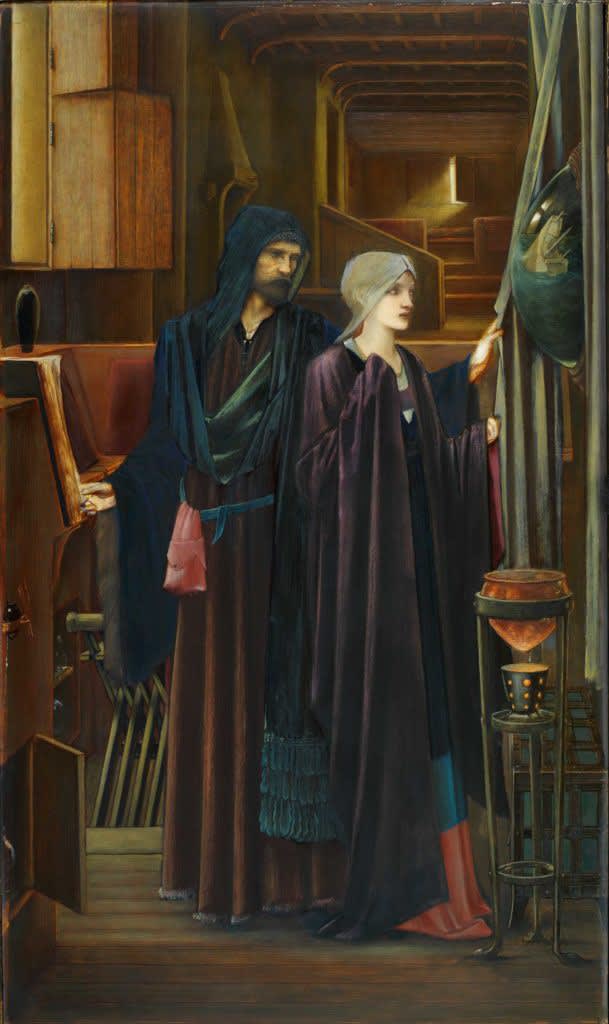
Edward BURNE-JONES
The Wizard, 1896 c.
Black and white chalk, watercolour and tempera, lightly squared in pencil, on buff paper
92 x 54 cm
SOLD
Provenance
Sir Philip Burne-Jones, Bt., 1919; Lady Lever Art Gallery; Christie’s, London, 6 June 1958, lot 14; Anonymous sale; Christie’s, London, 15 June 1971, lot 139; with Galleria Documenta, Turin.
Exhibitions
London, Japanese-British Exhibition, May-October 1910, No. 83.
Literature
R.R. Tatlock, A Record of the Collections in the Lady Lever Art Gallery at Port Sunlight, Cheshire, compiled by the 1st Viscount Leverhulme, 1928, no. 3989.
Edward BURNE-JONES
(London 1833 - 1898)
Edward Coley Burne-Jones (actually born Edward Coley Jones) is considered the greatest of the second-generation Pre-Raphaelites. His career as an artist began in London when he met his artistic hero Dante Gabriel Rossetti, who encouraged his early attraction to the arts. Rossetti himself, referring to Burne-Jones, wrote:
“Jones’s designs are marvels of finish and imaginative detail, unequalled by anything unless perhaps Albert Dürer’s finest works.”[1]
His emotional loneliness, resulting from a difficult childhood, led him to develop a vivid imagination and to seek solace in religion. This, combined with his love for poetry, but above all his passion for mediaevalism, distinguished him as a perfect adherent to the principles of the artistic confraternity.
His trip to Italy in 1859 was to prove of cardinal importance in his artistic career: the influence of the Italian Renaissance painting by Ghirlandaio and Botticelli was fundamental, but what really changed his way of thinking about art was Michelangelo. Hence the break with the first-generation Ruskinian Pre-Raphaelites; Burne-Jones was the spokesman for an aesthetic current according to which art should be valued as a mystical object capable of stimulating sensual enjoyment. He became the representative of an aestheticizing and Symbolist style, which in some respects was a prelude to the forms of Art Nouveau.
The drawing we are presenting here is the more refined of two compositional studies for an oil painting kept at the Birmingham Museum and Art Gallery. (Fig. 1)

Fig. 1
Burne-Jones, The Wizard, 1898
Courtesy Birmingham Museums Trust/Birmingham Museum & Art Gallery
It was done late in the artist’s life: although begun in 1891, account books indicate Burne-Jones was still engaged in the painting in 1896, which remained unfinished upon his death. It has been suggested that the wizard may have been the artist as a young man and that the girl was painted by Frances Horner, a painter and daughter of Burne-Jones’ long-time patron, William Graham.
The subject has been associated with Shakespeare’s The Tempest, in which an older man reveals the image of a shipwreck to a young girl in his convex mirror, even though Burne-Jones did not refer to the figures as Prospero and Miranda, but simply called this his ‘picture of the Maiden and the Necromancer’.[2]
What is certain is that its composition and the use of the convex mirror were inspired by Jan van Eyck’s The Arnolfini Portrait (National Gallery, London), a work which Burne-Jones described as “the most beautiful painting ever.”[3]
Join the mailing list
Subscribe to our newsletter to receive all the news about exhibitions, fairs and new acquisitions!